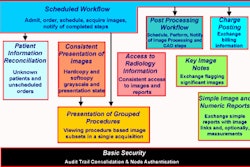As the largest radiology group in Austin, TX, the Austin Radiological Association has built an enviable market position. The 51-person private-practice group offers radiology services to 10 area hospitals and 15 outpatient clinics, chalking up more than 750,000 imaging procedures a year.
With annual growth of 20%, the ARA decided it needed digital image management to improve its service to referring physicians, reduce operational costs, and increase efficiency. The group also hoped to balance its workload, improve productivity, and stave off competitive threats, both from local groups and elsewhere via teleradiology, said Dr. Neal Rutledge, information technology committee chair for the ARA.
"In a digital age, our market isn't just Austin, it's everywhere," he said. "Regionalism in a digital world doesn't work."
Rutledge described his group's experience in implementing an enterprise-wide PACS network at "PACS 2002: Implementing CR/DR and Integrating the Healthcare Enterprise." The conference, held this March in San Antonio, was sponsored by the department of radiology at the University of Rochester in New York.
Following an 18-month purchasing process that included two requests for proposals (RFPs) and site visits, the ARA bought a Synapse PACS network from Fujifilm Medical Systems USA of Stamford, CT.
On-demand access
The group wanted a PACS that provided integrated RIS-PACS capability, as well as on-demand access to images, Rutledge said.
"I strongly believe that a rules-based approach doesn’t work well where there's dynamic change," he told AuntMinnie.com. "In our outpatient market, situations change quickly, and if somebody's really sick, we have to move that work quickly to some other place. A rules-based architecture isn't effective in that environment."
Of course, on-demand access on such a scale requires a high-bandwidth network. To meet the challenge, ARA has installed an OC-3 wide-area network (WAN) and a Symmetrix storage-area network (SAN) by EMC of Hopkinton, MA. All cases are stored at the central archive at ARA headquarters, which currently has room for 17 terabytes of storage.
The archive is scalable to accommodate additional storage needs, Rutledge said. As of 2003, ARA is planning to store long-term images in a lossy format.
The group has wired all of its hospital clients and outpatient clinics to the PACS. Initially, ARA kept all of its radiologists in the clinics where they were based, and set up digital "folders" for each site. Now, however, ARA and Fujifilm have begun implementing enterprise subspecialty digital folders, allowing subspecialty radiologists to read cases from anywhere in the enterprise.
The goal for report turnaround is 30 minutes. The group uses traditional transcription processes, but is planning to implement a central transcription system, Rutledge said. The ARA is also mulling the purchase of a speech recognition system that would be used in conjunction with a team of medical editors. The use of medical editors would free radiologists from inefficient time spent editing reports, Rutledge said.
The group has converted to soft-copy diagnostic reading for internal purposes, producing traditional dry-laser film to distribute images to referring physicians. But in early June, the ARA will begin offering a test group of referring physicians access to images and reports via its Web site. The clinicians will receive a login name and password, which will then give them access to relevant databases.
By the end of June, this service will be expanded to the rest of ARA's referring physicians. Even then, the group will still print film anytime a clinician wants it, Rutledge said.
"Our plan is not to cut them off from film, but make it easier for them to use the Internet," he said. "We'll provide them with options to choose from."
The group is projecting savings of $2 million in 2002 with its PACS installation, and expects to earn gross revenues of $78 million in 2002. ARA, along with its PACS consulting firm Integration Resources of Lebanon, NJ, has projected $24 million in gross savings from PACS over five years.
The estimate, drawn up before the PACS was installed, assumed a 5% to 10% increase in radiologist productivity, 80% filmless operation, a 10% to 15% increase in technologist productivity, and 4% to 5% inflation of supplies and labor. But the organization has seen even higher increases in radiologist productivity since the PACS was implemented, Rutledge said.
"We're actually seeing more than 20% improvement in radiologist productivity, and we're looking at possibly redistributing FTEs," he said. "And we may be able to cut FTEs."
Lessons learned
By installing its PACS, the ARA learned a number of lessons, including the need for process reengineering, according to Rutledge. "PACS is fundamentally changing how you work," he said.
It's also important to solicit radiologist input, and gain support from the IT department, he said. Rutledge recommends hiring a PACS administrator and engineers prior to installing the system.
Training can't be overlooked either. To adequately handle this task and prepare radiologists for conversion to soft-copy reading, the ARA formed a subcommittee to tackle education issues, and created a help desk for radiologists. The group now offers classes for all PACS users.
By Erik L. RidleyAuntMinnie.com staff writer
April 26, 2002
Related Reading
From planning to PACS: A community hospital's journey, April 11, 2002
HIPAA to make challenging, costly demands on radiology, March 18, 2002
Speech recognition, structured reporting eyed for efficiency gains, March 16, 2002
Radiology workstations need integration, automation, March 15, 2002
Copyright © 2002 AuntMinnie.com


















